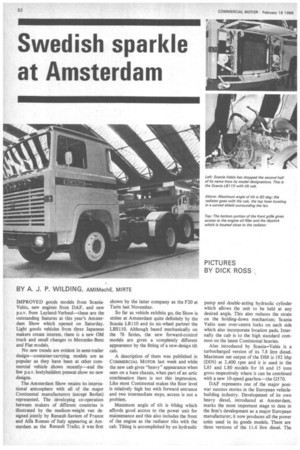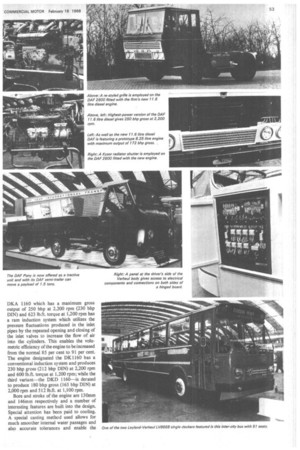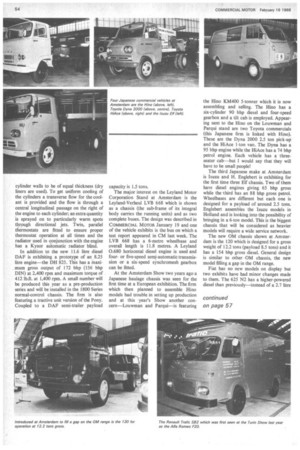Swedish sparkle at Amsterdam
Page 54

Page 55

Page 56

Page 59

If you've noticed an error in this article please click here to report it so we can fix it.
BY A. J. P. WILDING, AMIMechE, MIRTE
IMPROVED goods models from ScaniaVabis, new engines from DAF, and new p.s.v. from Leyland-Verheul—these are the outstanding features at this year's Amsterdam Show which opened on Saturday. Light goods vehicles from three Japanese makers create interest, there is a new OM truck and small changes to Mercedes-Benz and Fiat models.
No new trends are evident in semi-trailer design—container-carrying models are as popular as they have been at other commercial vehicle shows recently—and the few p.s.v. bodybuilders present show no new designs.
The Amsterdam Show retains its international atmosphere with all of the major Continental manufacturers (except Berliet) represented. The developing co-operation between makers of different countries is illustrated by the medium-weight van designed jointly by Renault-Saviem of France and Alfa Romeo of Italy appearing at Amsterdam as the Renault Trafic; it was first shown by the latter company as the F20 at Turin last November.
So far as vehicle exhibits go, the Show is stolen at Amsterdam quite definitely by the Scania LB110 and its six-wheel partner the LBS110. Although based mechanically on the 76 Series, the new forward-control models are given a completely different appearance by the fitting of a new-design tilt cab.
A description of them was published in COMMERCIAL MOTOR last week and while the new cab gives "heavy" appearance when seen on a bare chassis, when part of an artic combination there is not this impression. Like most Continental makes the floor level is relatively high but with forward entrance and two intermediate steps, access is not a problem.
Maximum angle of tilt is 60deg which affords good access to the power unit for maintenance and this also includes the front of the engine as the radiator tilts with the cab. Tilting is accomplished by an hydraulic pump and double-acting hydraulic cylinder which allows the unit to be held at any desired angle. This also reduces the strain on the holding-down mechanism; Scania Vabis uses over-centre locks on each side which also incorporate location pads. Internally the cab is to the high standard common on the latest Continental heavies.
Also introduced by Scania—Vabis is a turbocharged version of its 7.8 litre diesel. Maximum net output of the DS8 is 192 bhp (DIN) at 2,400 rpm and it is used in the L85 and L80 models for 16 and 15 tons gross respectively where it can be combined with a new 10-speed gearbox—the G570.
DAF represents one of the major postwar success stories in the European vehiclebuilding industry. Development of its own heavy diesel, introduced at Amsterdam, marks the most important stage to date in the firm's development as a major European manufacturer; it now produces all the power units used in its goods models. There are three versions of the 11.6 litre diesel. The DKA 1160 which has a maximum gross output of 250 bhp at 2,200 rpm (230 bhp DIN) and 623 lb.ft. torque at 1,200 rpm has a ram induction system which utilizes the pressure fluctuations produced in the inlet pipes by the repeated opening and closing of the inlet valves to increase the flow of air into the cylinders. This enables the volumetric efficiency of the engine to be increased from the normal 85 per cent to 91 per cent. The engine designated the DK1160 has a conventional induction system and produces 230 bhp gross (212 bhp DIN) at 2,200 rpm and 600 lb.ft. torque at 1,200 rpm; while the third variant—the DKD 1160—is derated to produce 180 bhp gross (165 bhp DIN) at 2,000 rpm and 512 lb.ft. at 1,100 rpm.
Bore and stroke of the engine are 130rnm and 146min respectively and a number of interesting features are built into the design. Special attention has been paid to cooling. A special casting method used allows for much smoother internal water passages and also accurate tolerances and enable the cylinder walls to be of equal thickness (dry liners are used). To get uniform cooling of the cylinders a transverse flow for the coolant is provided and the flow is through a central longitudinal passage on the right of the engine to each cylinder; an extra quantity is sprayed on to particularly warm spots through directional jets. Twin, parallel thermostats are fitted to ensure proper thermostat operation at all times and the radiator used in conjunction with the engine has a Kysor atitomatic radiator blind.
In addition to the new 11.6 litre diesel DAF is exhibiting a prototype of an 8.25 litre engine—the DH 825. This has a maximum gross output of 172 bhp (156 bhp DIN) at 2,400 rpm and maximum torque of 412 lb.ft. at 1,400 rpm. A small number will be produced this year as a pre-production series and will be installed in the 1800 Series normal-control chassis. The firm is also featuring a tractive unit version of the Pony. Coupled to a DAF semi-trailer payload capacity is 1.5 tons.
The major interest on the Leyland Motor Corporation Stand at Amsterdam is the Leyland-Verheul LVB 668 which is shown as a chassis (the sub-frame of its integral body carries the running units) and as two complete buses. The design was described in COMMERCIAL MOTOR January 19 and one of the vehicle exhibits is the bus on which a test report appeared in CM last week. The LVB 668 has a 6-metre wheelbase and overall length is 11.8 metres. A Leyland 0.680 horizontal diesel engine is used and fouror five-speed semi-automatic transmission or a six-speed synchromesh gearbox can be fitted.
At the Amsterdam Show two years ago a Japanese haulage chassis was seen for the first time at a European exhibition. The firm which then planned to assemble Hino models had trouble in setting up production and at this -year's Show another concern—Louwman and Parqui—is featuring
the Hino KM400 5-tonner which it is now assembling and selling. The Hino has a six-cylinder 90 bhp diesel and four-speed gearbox and a tilt cab is employed. Appearing next to the Hino on the Louwman and Parqui stand are two Toyota commercials (this Japanese firm is linked with Hino). These are the Dyna 2000 2.5 ton pick-up and the HiAce 1-ton van. The Dyna has a 95 bhp engine while the HiAce has a 74 bhp petrol engine. Each vehicle has a threeseater cab—but I would say that they will have to be small people!
The third Japanese make at Amsterdam is Isuzu and H. Englebert is exhibiting for the first time three Elf chassis. Two of them have diesel engines giving 65 bhp gross while the .third has an 88 bhp gross petrol. Wheelbases are different but each one is designed for a payload of around 2.5 tons. Englebert assembles the Isuzu models in Holland and is looking into the possibility of bringing in a 6-ton model. This is the biggest chassis that will be considered as heavier models will require a wide service network.
The new OM chassis shown at Amsterdam is the 120 which is designed for a gross weight of 12.2 tons (payload 8.5 tons) and it has a 154 bhp gross diesel. General design is similar to other • OM chassis, the new model filling a gap in the OM range.
Fiat has no new models on display but two exhibits have had minor changes made to them. The 625 N2 has a higher-powered diesel than previously—instead of a 2.7 litre 66 bhp unit, the engine has a 3.12 litre capacity and output of 77 bhp gross. A similar change has been made to the 650 El 11-ton-gross model but while the engine has been changed, capacity and output have not, the alteration like that to the 625 being in the interests of standardization.
There has also been an engine change in the Mercedes-Benz 406/408 range. These light commercial vehicles are now supplied with a 65 bhp gross diesel or 94 or 83 bhp gross petrol engines. And in the heavier chassis there is now a Mercedes-Benz LPS 1623 tractive unit specially designed for container transport (or box-van semitrailers). To reduce overall height on this use rear suspension is changed to restrict the height of a fifth-wheel coupling plate to 4ft 1.6in. when unladen; with 11.00-20 tyres and an unladen container total height should not exceed 12.6ft.
Except for the name on the front, the Renault Trafic SB2 is identical to the Alfa Romeo F20 seen at Turin. Front wheel, drive is used with independent suspension all round and the design gives extremely low floor height to the rear of the van.
As already pointed out there has been little change in p.s.v. body design since the last Amsterdam Show and trailers and semitrailers follow the same general pattern. An interesting new design from Hub o consists of a running gear for use with integral-tank semi-trailers. It has a two-point mounting on which the sub-frame pivots and both axles are steered through a link connecting the bogie to the rear cr6ss-member of the tractive unit.
On a semi-trailer shown by Groenewegen the rearmost axle tracks and its track rod is connected to an air bellows pressurized at 4 atmospheres. As the wheels turn, movement of the track rods builds up the pressure to 6 or 7 atmospheres and this speeds up the return of the wheels to the straight-ahead position after the bend has been taken.
Most of the interest at Continental shows centres on the vehicle stands but at Amsterdam one of the component stands also has an important exhibit. The Dutch associate of Judd of Germany is showing brake linings incorporating sintered-metal pads in the friction material. It is claimed that these give a constant friction up to 600deg C, up to three times the normal lining life and up to twice the life from brake drums. The sintered metal pads help in heat dissipation and it is said that cracking and crazing of brake drums is eliminated.
(The Show closes on February 18).




















































































































